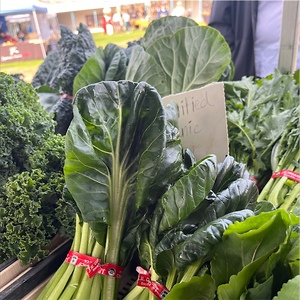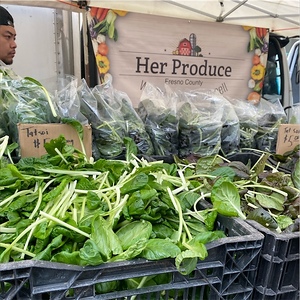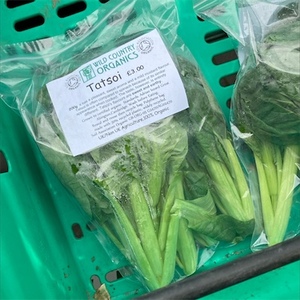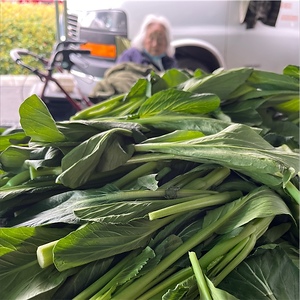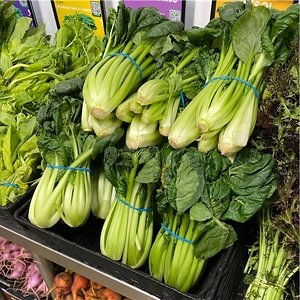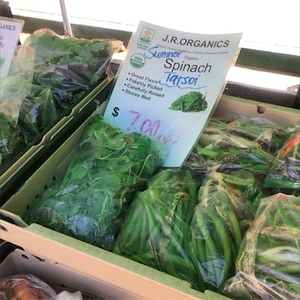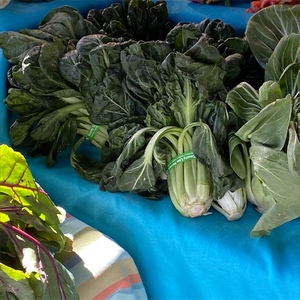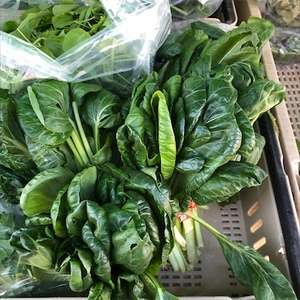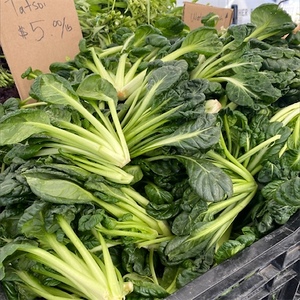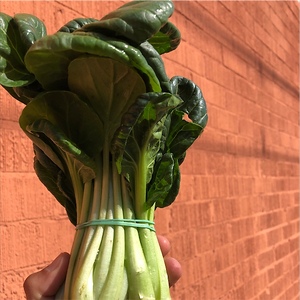


Tatsoi
Estimated Inventory, 3 lbs : 0
Description/Taste
Tatsoi is a small, low-growing plant, averaging 20 to 25 centimeters in height and 25 to 30 centimeters in diameter, that grows a dense rosette of oval, spoon-shaped leaves. The leaves are glossy with a slight, cupped appearance, first harvested when they are approximately 10 centimeters in length and range in color from pale to dark green. The leaves also have a smooth, soft, and semi-crinkled surface displaying prominent veining that connects into a white or green stem, depending on the variety. The stems are crisp, aqueous, and tender, similar to the texture of celery heart. Raw Tatsoi has a mild, sweet flavor with nutty, tangy, and mustard-like nuances. When cooked, the leaves soften into a texture reminiscent of cooked spinach and develop a neutral, green earthiness.
Seasons/Availability
Tatsoi is available in the spring and fall. In milder climates, the greens may be grown year-round.
Current Facts
Tatsoi, botanically classified as Brassica rapa subsp. narinosa, is an ancient, non-heading mustard green belonging to the Brassicaceae family. The curved, spoon-like leaves have been grown in Asia for thousands of years, favored for their mild, sweet, and tangy flavor. Tatsoi is known by several names, including Wu Ta Cai in China, Tasai in Japan, Spoon Mustard, Broadbeak Mustard, Rosette Bok Choy, Spinach Mustard, Tat Soy, and Chinese Flat Cabbage. The crisp greens are a cool-season plant that can withstand frost, snow, and cold temperatures. There are multiple varieties of Tatsoi, some with white stems while other cultivars have green, but in local markets, the varieties are generally labeled as Tatsoi for simplicity. Tatsoi was once primarily associated with Asian cuisine, as its roots stem from Asia, but recently the greens have been introduced worldwide, fusing into many different cuisines. Tatsoi remains a specialty green outside of Asia, found through local markets, but the hardy plants are also increasingly being cultivated by home gardeners, valued for their cut-and-come again nature, cold tolerance, and succession planting abilities.
Nutritional Value
Tatsoi is a good source of vitamins A and C to boost the immune system, protect the cells against free radical damage, and reduce inflammation. The greens are also a good source of potassium to balance fluid levels within the body, calcium to strengthen bones and teeth, and provide some folic acid, iron, and antioxidants. In addition to vitamins and minerals, Tatsoi contains glucosinolates. These natural compounds are believed to create metabolites that help activate reactions within the body to potentially protect against diseases that damage cells.
Applications
Tatsoi is versatile green with a mild, subtly tangy flavor well suited for raw or lightly cooked applications. Young leaves are often favored for mixed salads and are an excellent accompaniment to other greens such as spinach, arugula, watercress, pea tendrils, and mizuna. Tatsoi can also be layered into sandwiches, torn and used as a topping over pizza and tacos, or blended into pesto as a unique variation. The crisp greens can be incorporated as a substitute in recipes for bok choy, and when young, the tender leaves can be used in place of spinach. Tatsoi is also frequently utilized in lightly cooked preparations, including stir-frying, sautéing, steaming, and braising. The leaves and stems can be chopped and baked into quiche, stir-fried with other vegetables as a side dish, sauteed as a bed of greens for fish, wilted with warm sauces or dressings for a softer consistency, or mixed into soups just before serving. Beyond raw and cooked preparations, Tatsoi can be pickled to extend its shelf life and served as a fermented flavoring in stir-fries, soups, and noodle dishes. Tatsoi pairs well with aromatics, including basil, mint, ginger, scallions, garlic, and chives, citrus, apples, berries such as strawberries, blueberries, cranberries, and blackberries, legumes, tofu, fish, poultry, and avocado. The greens also complement ingredients rich in umami such as scallops, mushrooms, seaweed, and sesame and fermented ingredients such as fish sauce, soy sauce, and vinegar. Tatsoi will keep 3 to 5 days when unwashed, wrapped in a damp paper towel, and stored in a plastic bag in the refrigerator. The greens can also be blanched, rinsed with cold water, and frozen for extended use.
Ethnic/Cultural Info
In Korea, Tatsoi is commonly used to make kimchi. The fermented vegetable mixture is considered one of Korea's most traditional and representative culinary dishes and is fluid, allowing for many variations and adaptations. Kimchi was initially created as a method to preserve fresh vegetables during the winter season, and records of making kimchi can be traced back to over 3000 years ago. Since ancient times, kimchi possesses a balanced flavor profile containing sweet, sour, salty, spicy, and bitter tastes. These five flavors are believed to bring balance and harmony to the body and also intertwine with the philosophy of the five elements of life. Kimchi is traditionally served with rice and is valued among Korean households for providing healthy bacteria to supplement digestion and boost immunity. In the modern-day, there are many different kinds of kimchi comprised of varying ingredients, but the primary type typically uses fermented cabbage with spices and chile pepper powder. Mustard greens, including Tatsoi, are popular kimchi variations and provide diverse nutrients and flavors. Koreans often view kimchi as a living piece of their history. Recipes have been passed between generations for thousands of years, and these recipes are also being adapted and modernized to reflect the changing times. Tatsoi can be fermented on its own, or it can be combined with other greens or radishes for added texture.
Geography/History
Tatsoi is native to a region near the Yangtze River in Central China, where it has been cultivated since at least the 6th century. One of the first records of Tatsoi was documented by Chinese herbalist Li Shizhen in the 16th century. Shizhen studied the nutritional value of the greens and practical medicinal applications. Over time, Tatsoi was introduced into Korea and surrounding countries. Tatsoi was eventually brought to Japan in the late Edo period, and the greens were believed to have been taken from China by Japanese soldiers returning home from the Russo-Japanese War. Tatsoi became widely adapted into Japanese cuisine and was so revered that the leaves were accepted into Japanese history as an essential ancient green. Today Tatsoi has been spread worldwide through globalization, migrating peoples, and the rise of online seed retailers. The greens are cultivated commercially and grown in home gardens, and when in season, they can be found fresh through farmer’s markets, specialty grocers, and in home gardens.
Recipe Ideas
Recipes that include Tatsoi. One



